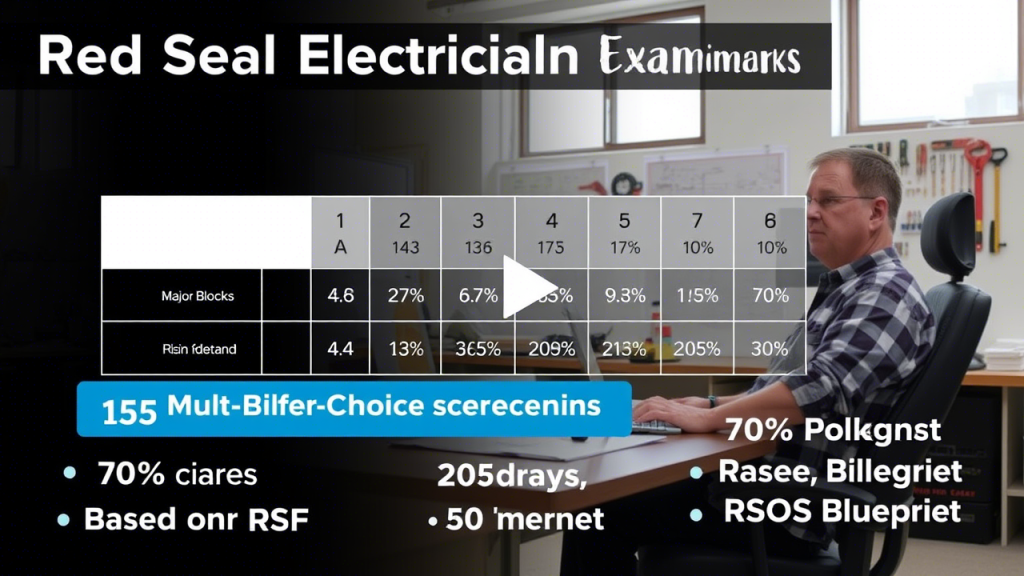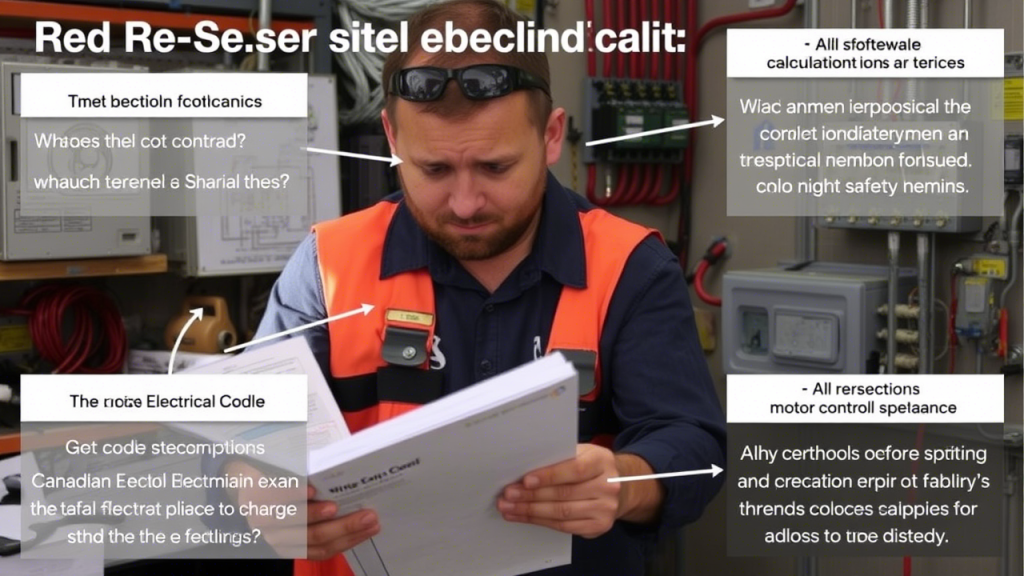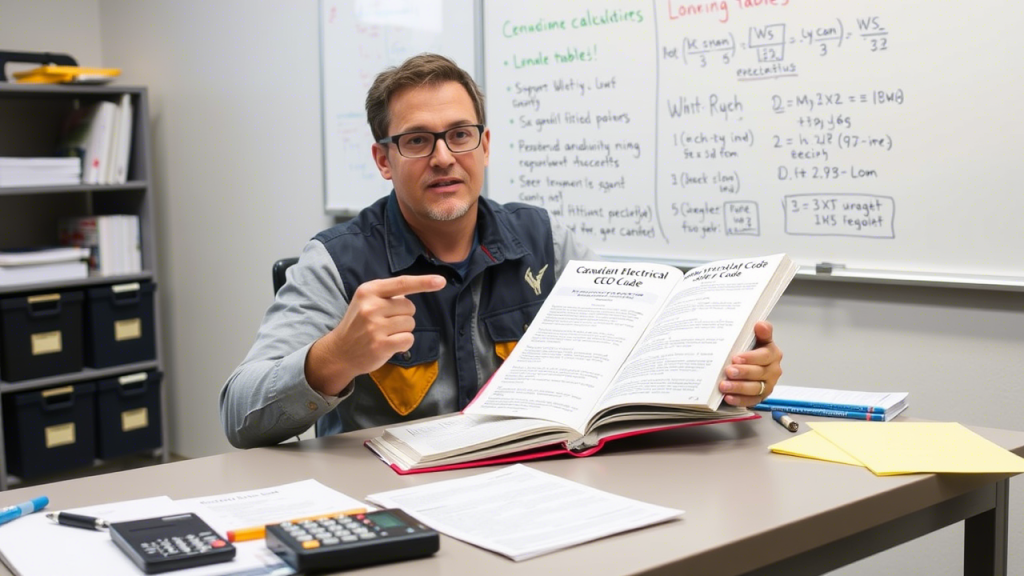Dominate Your Test: The Ultimate Guide to Red Seal Electrician Exam Questions (2025)
If you’re on the path to becoming a certified journeyperson in Canada, the Red Seal Endorsement is the highest standard you can achieve. But standing between you and that goal is the Interprovincial Red Seal Examination, a test known for its complexity and breadth. The key to success isn’t just about knowing the trade; it’s about knowing how to tackle the specific Red Seal Electrician exam questions.
Many talented apprentices feel anxious about this exam, and for good reason. The questions are designed to test the full scope of your knowledge, from intricate code interpretation to complex theoretical problems. This guide is here to demystify the process. We’ll break down the types of questions you’ll face, provide realistic examples, and share proven strategies to help you prepare, practice, and pass with confidence.

What is the Structure of the Red Seal Electrician Exam?
The Red Seal exam for Construction Electricians (NOC 72200) consists of 125 multiple-choice questions. You will have four hours to complete the exam, and the passing grade is 70%.
These questions are not pulled from thin air. They are meticulously developed by industry experts from across Canada and are based on the Red Seal Occupational Standard (RSOS). Understanding this document is the first step to mastering the exam.
The Secret Weapon: Understanding the Red Seal Occupational Standard (RSOS)
The RSOS is the blueprint for the entire exam. It breaks down the electrician trade into “Major Blocks,” “Tasks,” and “Sub-tasks.” The number of questions on the exam directly corresponds to the percentage weighting given to each Major Block.
The Major Blocks for the Construction Electrician trade are:
- Block A – Performs common occupational skills (16 questions): Safety, tools, prints, and communication.
- Block B – Installs, services, and maintains generating, transmission and distribution systems (22 questions): Services, transformers, and high-voltage systems.
- Block C – Installs, services, and maintains wiring systems (51 questions): This is the largest section. It covers raceways, conductors, branch circuits, and grounding/bonding.
- Block D – Installs, services, and maintains motors and control systems (21 questions): All things related to motors and their control.
- Block E – Installs, services, and maintains signaling and communication systems (15 questions): Fire alarms, security, and data systems.
Pro Tip: Download the RSOS from the official [Red Seal Canada website](https://www.red-seal.ca/). Use it as a checklist to guide your studies. If Block C makes up the bulk of the exam, it should make up the bulk of your study time.

Breaking Down the 4 Main Types of Red Seal Electrician Exam Questions
The exam uses several question formats to test your skills. Let’s explore the main types.
1. Code & Knowledge-Based Questions
These are direct questions designed to test your knowledge of a specific rule in the Canadian Electrical Code (CEC) or a general trade fact. They often require you to identify the minimum or maximum requirement for a situation.
- Example: “What is the minimum bend radius for a 53mm TECK90 cable?”
- How to approach: These are the most straightforward questions if you know your CEC. Success here comes from repetition and being able to navigate the codebook quickly.
2. Schematic & Print Reading Questions
These questions will present you with a wiring diagram, a schematic, or a section of a blueprint and ask you to interpret it.
- Example: You might see a motor control circuit diagram and be asked, “Which component provides overload protection for the motor?”
- How to approach: Practice is key. You need to be comfortable identifying symbols and understanding how different components interact within a system.
3. Theory & Calculation Questions
These are often multi-step problems that require you to apply electrical theory and perform calculations. They are designed to be challenging.
- Example: “A 25 HP, 3-phase, 460V squirrel cage motor has an efficiency of 92%. What is its full-load running current?”
- How to approach: You must have a firm grasp of Ohm’s Law, power formulas, voltage drop calculations, and motor theory. Write down your formulas and work through the problem step-by-step. Don’t rush.
4. Safety-Related Questions
Safety is paramount in the trade and on the exam. These questions test your knowledge of safe work practices, lockout/tagout procedures, and PPE requirements.
- Example: “What is the first step a worker should take before beginning a lockout/tagout procedure?”
- How to approach: Think “safety first.” The correct answer is always the one that ensures the highest level of safety for you and your coworkers.

Sample Red Seal Electrician Exam Questions & Answer Walkthroughs
Let’s walk through a couple of realistic examples.
Sample Question 1 (Code-based): According to the CEC, what is the maximum number of 14 AWG conductors permitted in a standard 4″ x 2 1/8″ device box?
- (A) 5
- (B) 6
- (C) 7
- (D) 8
Walkthrough: This question requires you to use CEC Table 23. You find the box size in the table and cross-reference it with the conductor size (14 AWG). The table specifies a maximum of 6 conductors. Therefore, the correct answer is (B).
Sample Question 2 (Calculation-based): A 120V circuit supplies a resistive load drawing 12A. If the circuit is 50 meters long and uses 12 AWG copper conductors, what is the approximate voltage drop?
- (A) 2.1V
- (B) 3.8V
- (C) 5.9V
- (D) 7.2V
Walkthrough:
- Find the resistance of the conductor. From CEC Table D3, 12 AWG copper wire has a resistance of 5.25 ohms/km.
- Calculate the total length of the wire. The circuit is 50m long, but current travels there and back, so the total length is 100m (0.1 km).
- Calculate the total resistance. 5.25 ohms/km * 0.1 km = 0.525 ohms.
- Use Ohm’s Law (V = I x R). V = 12A * 0.525 ohms = 6.3V. The closest answer is 5.9V, accounting for slight variations in tables or rounding. Therefore, the correct answer is (C).
Top 5 Strategies to Master Your Exam Preparation
Strategy 1: Make the CEC Your Best Friend
You must be able to navigate the CEC efficiently. Use tabs to mark critical sections like Tables, grounding/bonding (Section 10), motors (Section 28), and services (Section 6). The more you practice looking up rules, the faster you will become.
Strategy 2: Use a High-Quality Exam Simulator
This is the single most important investment you can make in your preparation. A good exam simulator with a large bank of Red Seal Electrician exam questions will get you comfortable with the format, timing, and difficulty. Look for providers that offer detailed explanations for each answer.
Strategy 3: Focus on Major Block & Task Weightings
Use the RSOS to guide your study. Spend the most time on wiring systems (Block C), as it accounts for the most questions. If you are weak on motors (Block D), dedicate specific time to mastering those calculations.
Strategy 4: Don’t Just Memorize, Understand
The exam tests your ability to apply knowledge. Don’t just memorize that a rule exists; understand why it exists. Understanding the safety principle behind a code rule will help you solve problems you haven’t seen before.
Strategy 5: Simulate Exam Day Conditions
When doing practice tests, treat them like the real thing. Give yourself a four-hour time limit, put your phone away, and use only the approved materials (calculator, code book during study). This builds mental stamina for the real exam.

Common Mistakes to Avoid When Answering Questions
- Misreading the Question: Pay close attention to words like “NOT,” “MINIMUM,” or “MAXIMUM.”
- Second-Guessing Yourself: Your first instinct is often correct. Don’t change answers unless you’ve discovered a clear error in your initial logic.
- Poor Time Management: If a question is too hard, flag it and come back later. It’s better to answer all the questions you know first.
Where to Find the Best Practice Exams and Resources
- Official Red Seal Site: While they don’t provide full practice exams, they offer sample questions and the invaluable RSOS document.
- CSA Group (CSA OnDemand™): The publisher of the CEC has prep tools and resources. Consider their subscription service for online access to the codebook and related documents.
- Reputable Online Training Providers: Companies like the Electrical Contractors Association of Ontario (ECAO) or private trainers like https://www.google.com/search?q=sampsonelearn.com offer robust exam preparation platforms. Investing in one is highly recommended.
Frequently Asked Questions (FAQs)
Q: Is the Red Seal Electrician exam open book? A: No, the exam is closed book. You must rely on your knowledge of theory and your ability to recall and apply CEC rules.
Q: Can I use a calculator on the exam? A: Yes, you are permitted to use a non-programmable scientific calculator.
Q: What version of the CEC is the exam based on? A: The exam is always based on the current, legally-adopted version of the Canadian Electrical Code in your province or territory. As of 2025, this is typically the 2024 CEC. Always verify with your provincial apprenticeship authority.
Your Next Step After Passing the Exam
Passing the Red Seal exam is a career-defining achievement. It demonstrates that you have met a national standard of excellence. It opens doors to higher wages, leadership roles, and the ability to work in any province or territory in Canada without further testing.
This exam is a challenge, but with dedicated preparation focused on understanding and practicing with high-quality.

Internal Links: